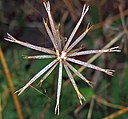
Original file (3,041 × 1,882 pixels, file size: 3.19 MB, MIME type: image/jpeg)
| This is a file from the Wikimedia Commons. Information from its description page there is shown below. Commons is a freely licensed media file repository. You can help. |
Summary
| DescriptionBidens sp. (beggar's ticks) (Smyth County, Virginia, USA) 1 (30384875776).jpg |
Bidens sp. - beggar's ticks in Virginia, USA. (October 2016) Plants are multicellular, photosynthesizing eucaryotes. Most species occupy terrestrial environments, but they also occur in freshwater and saltwater aquatic environments. The oldest known land plants in the fossil record are Ordovician to Silurian. Land plant body fossils are known in Silurian sedimentary rocks - they are small and simple plants (e.g., Cooksonia). Fossil root traces in paleosol horizons are known in the Ordovician. During the Devonian, the first trees and forests appeared. Earth's initial forestation event occurred during the Middle to Late Paleozoic. Earth's continents have been partly to mostly covered with forests ever since the Late Devonian. Occasional mass extinction events temporarily removed much of Earth's plant ecosystems - this occurred at the Permian-Triassic boundary (251 million years ago) and the Cretaceous-Tertiary boundary (65 million years ago). The most conspicuous group of living plants is the angiosperms, the flowering plants. They first unambiguously appeared in the fossil record during the Cretaceous. They quickly dominated Earth's terrestrial ecosystems, and have dominated ever since. This domination was due to the evolutionary success of flowers, which are structures that greatly aid angiosperm reproduction. Beggar's ticks are a member of the daisy/sunflower family. Their fruit are a type of "burr" that readily sticks to the fur of animals or the clothing of people. A cluster of radiating burrs occurs at the tips of branches. Individual burrs are easily detached when disturbed. The distal ends are trifid and barbed (click on the above photo to zoom in and see the small barbs). I probably had about a thousand of these on my pants, shirt, shoelaces, and hat after visiting this site. Classification: Plantae, Angiospermophyta, Asterales, Asteraceae Locality: Grassy Branch Outcrop - base of roadcut on the northern side of Rt. 603, just downstream from the Big Laurel Creek-Grassy Branch confluence, west of the town of Troutdale & east of the town of Konnarock, southern Smyth County, southwestern Virginia, USA More info. at: <a href="https://en.wikipedia.org/wiki/Bidens" rel="nofollow">en.wikipedia.org/wiki/Bidens</a> |
|||
| Date | ||||
| Source | Bidens sp. (beggar's ticks) (Smyth County, Virginia, USA) 1 | |||
| Author | James St. John | |||
| Other versions |
|
Licensing
- You are free:
- to share – to copy, distribute and transmit the work
- to remix – to adapt the work
- Under the following conditions:
- attribution – You must give appropriate credit, provide a link to the license, and indicate if changes were made. You may do so in any reasonable manner, but not in any way that suggests the licensor endorses you or your use.
| This image was originally posted to Flickr by James St. John at https://flickr.com/photos/47445767@N05/30384875776 (archive). It was reviewed on 12 November 2019 by FlickreviewR 2 and was confirmed to be licensed under the terms of the cc-by-2.0. |
12 November 2019
Captions
Items portrayed in this file
depicts
some value
14 October 2016
0.01666666666666666666 second
6.2 millimetre
image/jpeg
6deeb5b6e9db33eed8af5e608e761dd8d92d1cd8
3,349,897 byte
1,882 pixel
3,041 pixel
File history
Click on a date/time to view the file as it appeared at that time.
| Date/Time | Thumbnail | Dimensions | User | Comment | |
|---|---|---|---|---|---|
| current | 04:44, 12 November 2019 |  | 3,041 × 1,882 (3.19 MB) | Ser Amantio di Nicolao | Transferred from Flickr via #flickr2commons |
File usage
Metadata
This file contains additional information, probably added from the digital camera or scanner used to create or digitize it.
If the file has been modified from its original state, some details may not fully reflect the modified file.
| Camera manufacturer | Canon |
|---|---|
| Camera model | Canon PowerShot D10 |
| Exposure time | 1/60 sec (0.016666666666667) |
| F-number | f/8 |
| ISO speed rating | 80 |
| Date and time of data generation | 14:21, 14 October 2016 |
| Lens focal length | 6.2 mm |
| Image title | |
| Width | 4,000 px |
| Height | 3,000 px |
| Bits per component |
|
| Pixel composition | RGB |
| Orientation | Normal |
| Number of components | 3 |
| Horizontal resolution | 180 dpi |
| Vertical resolution | 180 dpi |
| Software used | Adobe Photoshop Elements 13.0 (Macintosh) |
| File change date and time | 00:52, 19 October 2016 |
| Y and C positioning | Co-sited |
| Exif version | 2.21 |
| Date and time of digitizing | 14:21, 14 October 2016 |
| Meaning of each component |
|
| Image compression mode | 3 |
| Shutter speed | 5.90625 |
| APEX aperture | 6 |
| Exposure bias | −2 |
| Maximum land aperture | 2.96875 APEX (f/2.8) |
| Metering mode | Pattern |
| Flash | Flash fired, compulsory flash firing, red-eye reduction mode |
| Supported Flashpix version | 1 |
| Color space | sRGB |
| Focal plane X resolution | 16,460.905349794 |
| Focal plane Y resolution | 16,483.516483516 |
| Focal plane resolution unit | inches |
| Sensing method | One-chip color area sensor |
| File source | Digital still camera |
| Custom image processing | Normal process |
| Exposure mode | Manual exposure |
| White balance | Auto white balance |
| Digital zoom ratio | 1 |
| Scene capture type | Portrait |
| Lens used | 6.2-18.6 mm |
| Date metadata was last modified | 18:52, 18 October 2016 |
| Unique ID of original document | 47699D9138C8E9B3895A0D6277680A07 |
